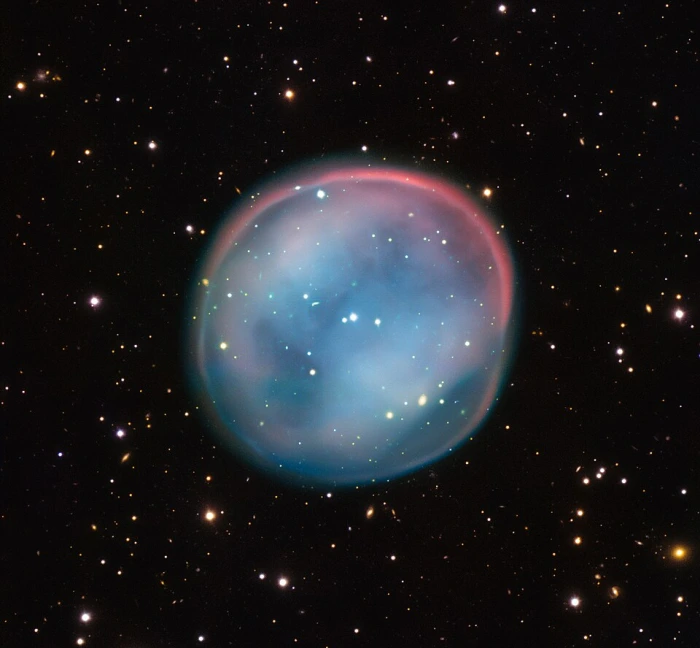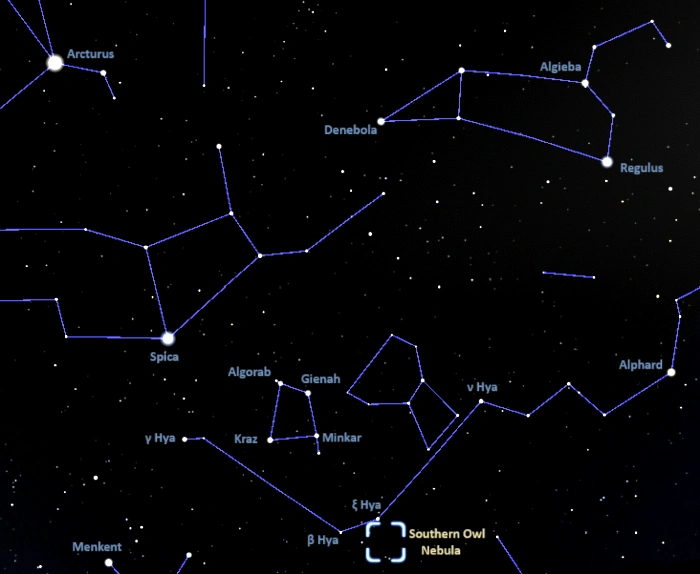The Southern Owl Nebula is a planetary nebula located 2,030 light years away in the constellation Hydra. With an apparent magnitude of 17.4, it cannot be observed in amateur telescopes. It is catalogued as ESO 378-1 in the European Southern Observatory Catalogue and PK 283+25 1 (PLN 283+25.1) in the Perek-Kohoutek catalogue of planetary nebulae.
The Southern Owl Nebula is about 4 light-years across and has an apparent diameter of 3.017 by 3.017 arcminutes. It was nicknamed the Southern Owl because it resembles the much brighter and better-known Owl Nebula (Messier 97) in the northern constellation Ursa Major (the Great Bear). Like M97, the Southern Owl appears round and symmetric and has fainter, darker regions that resemble an owl’s eyes. However, unlike its northern hemisphere counterpart, the Southern Owl Nebula cannot be spotted in backyard instruments.

This extraordinary bubble, glowing like the ghost of a star in the haunting darkness of space, may appear supernatural and mysterious, but it is a familiar astronomical object: a planetary nebula, the remnants of a Sun-like star. This is the best view of the little-known object ESO 378-1 yet obtained and was captured by ESO’s Very Large Telescope in northern Chile. Image credit: European Southern Observatory (ESO) (CC BY-SA 4.0)
Despite the name, planetary nebulae do not have anything to do with planets. They are the final stage in the evolution of low- and intermediate-mass stars like the Sun. They are composed of material ejected from the stars in the late stages of their life cycle. When evolved stars reach the asymptotic giant branch (AGB) phase, they lose as much as 50 to 70 percent of their mass through a powerful stellar wind. As the material is expelled into space, it forms complex shapes that are later ionised by the hot stellar core. These objects were first referred to as planetary nebulae by the German-born British astronomer William Herschel in the 1780s, who described them as resembling planets.
Like all planetary nebulae, the Southern Owl Nebula formed when an aging star reached the end of its life and expelled its outer layers of gas into the interstellar medium. The surrounding gas glows because it is ionised by the ultraviolet radiation of the remaining hot stellar core that will keep cooling and fading as a white dwarf.
Planetary nebulae are a short-lived phenomenon. Their life is measured in only tens of thousands of years, while Sun-like stars live about 10 billion years. As the nebular material expands away from the central star, it fades away and disappears into the surrounding space, and the central stars gradually cool and become dimmer.
Like supernovae, planetary nebulae like the Southern Owl play a crucial role in the chemical enrichment and evolution of galaxies. They enrich the interstellar medium with heavier elements such as carbon, oxygen and nitrogen. These elements (metals) can be used as raw materials to form new generations of stars. The heavier elements are produced in the cores of red giant stars as they evolve through the AGB phase. New stars formed from these recycled materials will have higher metallicities.
Facts
The northern Owl Nebula is a prototype for a class of nebulae known as strigiform nebulae (“owl-like” nebulae). The Southern Owl Nebula is a member of the class, as are the Diamond Ring Nebula (Abell 33) in the constellation Hydra and NGC 6742 (Abell 50) in Draco. Other potential members or precursors of the class include the Robin’s Egg Nebula (NGC 1360) in the constellation Fornax, IC 1454 in Cepheus, Kohoutek 1-20 (K 1-20) in Andromeda, and NGC 6894 in Cygnus.
The class was proposed by a team of astronomers led by M. T. García-Díaz of the Institute of Astronomy, National Autonomous University of Mexico, in a study published in 2018. The cosmic owls have a double shell structure, asymmetric inner cavities without bright rims, and low-luminosity central stars with high gravity that do not show evidence of a present-day stellar wind.
The stellar wind in these nebulae is weak because the nebulae are highly evolved. They have global expansion velocities of 30 – 40 km s-1. The pressurization of the strigiform cavities is the result of an earlier phase in the evolution of the central stars, when the stellar winds were much stronger and the stars had higher luminosity.
Location
The Southern Owl Nebula lies in the southern sky, in the faint constellation of Hydra. It appears south of the yellow giant star Xi Hydrae (mag. 3.54). Xi Hydrae can be found by extending a line from Algorab through Minkar in the neighbouring Corvus. The bright stars of Corvus form an asterism known as the Sail or Spica’s Spanker, which stands out in the region of the sky near the bright Spica in Virgo.
At declination -34° 22’, the Southern Owl never rises for observers north of the latitude 55° N.

The location of the Southern Owl Nebula, image: Stellarium
Southern Owl Nebula – ESO 378-1
| Constellation | Hydra |
| Object type | Planetary nebula |
| Right ascension | 11h 26m 43.7671247699s |
| Declination | −34° 22′ 11.178770560″ |
| Apparent magnitude | 17.4 |
| Apparent size | 3’.017 x 3’.017 |
| Distance | 2,030 light-years (622 parsecs) |
| Radius | 2 light-years |
| Names and designations | Southern Owl Nebula, ESO 378-1, PK 283+25 1, PLN 283+25.1, PN K 1-22, PN G283.6+25.3, PN V-V 3-1, AG82 136, AM 1124-340, GALEX J112643.7-342209, TIC 57352750, Tol 1124-340, Tol 53, WISE J112643.79-342211.3, UCAC4 279-061959, IRAS 11242-3405, IRAS F11242-3405, 2MASS J11264377-3422113, Gaia DR2 5399388964749811456 |